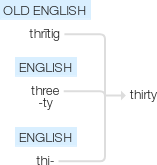Thirty
Old English thrītig (see three, -ty2). The spelling with initial thi- is recorded in literature in the 15th century, and has been the prevalent form since the 16th century.
wiktionary
From Middle English thirty, metathetic alternant of Middle English thriti, þrittiȝ, from Old English þritiġ(“thirty”), from Proto-Germanic *þrīz tigiwiz(“thrity”, literally “three tens”), equivalent to three + -ty. [1] [2] Cognate with Scots therty, tretty(“thirty”), West Frisian tritich(“thirty”), Dutch dertig(“thirty”), German dreißig(“thirty”).
etymonline
thirty (adj., n.)
"1 more than twenty-nine, twice fifteen; the number which is one more than twenty-nine; a symbol representing this number;" late 14c. metathesis of thritti, from Old English þritig, from þri, þreo "three" (see three) + -tig "group of ten" (see -ty (1)). Similar formation in Old Frisian thritich, Old Saxon thritig, Dutch dertig, Old High German drizzug, German dreissig.
The Thirty Years' War (1842) was a general European religious and dynastic power struggle, furiously destructive, waged 1618-48, mainly on German soil. The symbol -30- as printer and telegrapher's code to indicate the last sheet or line of copy or a dispatch is recorded from 1895. In 20c. jargon of newspaper journalism, it came to be a traditional sign-off signal and slang word for "the end."
